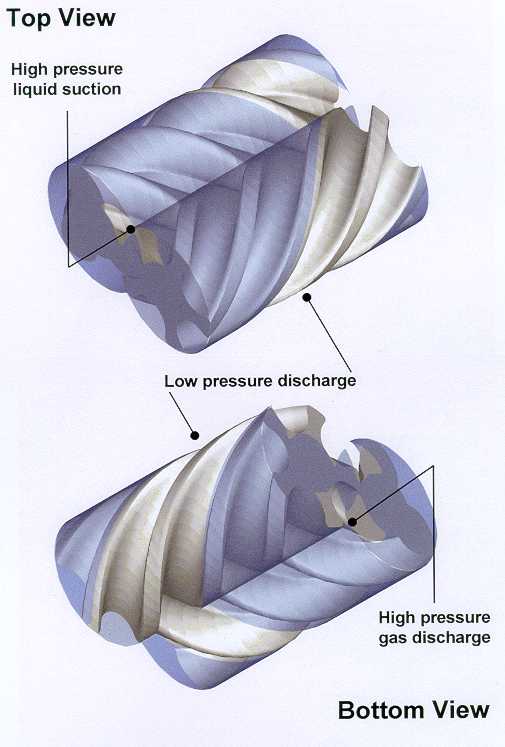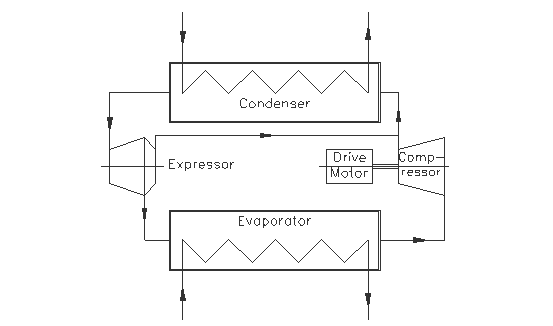![]()
Centre for Positive Displacement
Compressor Technology
The EXPRESSOR
a case study about the benefit of Company funded R&D
at
City University
There has been an ongoing Research & Development programme on Two-Phase Screw Expanders at City University since 1984.One application was the concept of a self driven Expander-Compressor unit called an "Expressor" as a replacement to the traditional throttle valve used in vapour compression cycle air conditioning and refrigeration systems. This would improve the plant capacity and performance and reduce operating costs by recovering power from the energy wasted in the two-phase expansion process. An analysis of such a device was published by City University workers for the first time in 1995 at an ASME Congress.
Carrier become interested in this idea, although they already owned the alternative technology of a two-phase turbine to perform the same function, because they recognizing the potential for higher efficiencies from screw expanders. Accordingly they have underwritten the continuation of the R&D program in this field at City University since 1996.
After peak screw expander efficiencies in excess of 70% were successfuly demonstrated under operating conditions replicating those in an industrial chiller unit, the program focussed on a cost-effective implementation of HVAC throttle loss power recovery. This joint effort by Carrier and City University London resulted in a patented single rotor pair Expressor.

The Expressor recovers power from the two-phase expansion of wet fluids, discharges the resulting low pressure liquid, and uses the power so generated to recompress part of the vapour formed during the expansion in a process lubricated, sealed unit which contains only two meshing helical rotors with

The rotors, which are in direct contact, are driven by an expanding two-phase fluid at a rotational speed which is determined entirely by the flow rate of the fluid. The performance characteristics of this machine are such that its volumetric, expansion and compression efficiencies vary little over a wide operating range.

High pressure supercritical fluid, subcooled liquid or wet vapour is admitted to one side of the rotors thereby forcing them to rotate. The fluid contained between the rotors and the casing flashes into vapour as rotation proceeds and the volume of its containment increases, thus performing expansion work.
When the containment volume reaches its maximum, ports are exposed through which virtually all the liquid and some of the vapour is discharged under the influence of pressure, centrifugal and gravitational forces.Further rotation cuts off the residual gas from the first discharge port and leads to a reduction in the containment volume, thus compressing the gas
The recompressed gas is then discharged through a third port at the far end and on the same side of the casing as the liquid discharge port.
Both the prototype, shown in the illustrations, and a more advanced version, with improved porting, have now been tested at City University, running on R113 under conditions which replicate a 500 ton chiller unit operating on R134a. Over a range of liquid entry flow rates of 7 - 13 kg/s with inlet and discharge pressures of 8.5 bar - 3.75 bar - 8.5 bar, the expressor operated extremely quietly and smoothly. Overall adiabatic efficiencies obtained under these conditions were in the range of 55% - 63%. This corresponds approximately to a combination of expansion efficiencies of 70-75% with compression efficiencies of 80-85%. No other means of power recovery from two-phase flow has yet been reported with comparable performance figures. Further tests are now to be carried out by Carrier in a full scale chiller unit.
The extreme simplicity of its design leads to a most cost effective method of recovering otherwise wasted energy which also leads to increased liquid recovery from the expansion process. Based on power saving considerations alone, the installed cost of an Expressor can be recovered in 3-6 months of operation. It may therefore be used to great advantage to improve the performance of:
Industrial Chiller Systems Refrigeration Plant Heat Pumps Gas Liquefaction Plant Cryogenic Systems

World patent rights for the single rotor pair Expressor have been filed by Carrier Corporation.City University sees opportunities for two-phase flow screw expansion-compression technology in general and the single rotor pair Expressor in particular outside the HVAC industry and is interested in discussing these applications with interested parties.